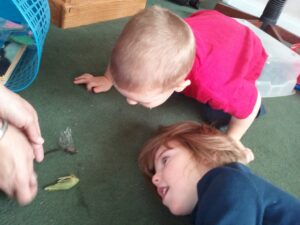
Sometimes something happens that dictates what you introduce to your children or grandchildren. That happened to me in 2011, when I was meeting with my grands weekly to engage in learning play.
Don and I sat on the balcony to enjoy the fall sunshine one afternoon. Right there on the deck was a perfectly preserved dragonfly. These happen to be my FAVORITE insect, next to the Cat Spider, which isn’t an insect. LOL A few days later, while I was walking to the car, there on the sidewalk, in plain sight, was a magnificent and dead katydid. Eureka, what an amazing find!!! You don’t see them often.
Naturally, I headed to the library for a few good books about insects. I knew that late October and early November are late in the season for finding many insects. I also knew that spring was the best time to teach about insects. However, I couldn’t resist sharing these magnificent specimens, and I knew I couldn’t wait until spring. So, insects it would be the next time I met with my grands.
When I got to their home, I asked Jack, Maggie, and Mary if they knew what insects were. They didn’t know the word insect, but recognized a bug when they saw it. : ) I asked them if they knew about dragonflies and katydids. They recognized the dragonfly but not the katydid.
We looked at the books and talked about dragonflies and other insects. When I came across the picture of the katydid, we came up with a prank that they could play on their Aunt Kate. I suggested that when their Aunt Kate came over, they could say “Well, how ya doin Katydid!” They laughed at that, and it made their day.
I asked the children if they had ever seen a real dragonfly or a katydid up close. No, they hadn’t. I asked them if they would like to. Jack got a worried expression on his face and hesitantly said, “OK.” I opened my box of bugs, and he took a few steps backward. He put his hand over his mouth. He was afraid. I picked up the dragonfly and showed them the wings and the huge eyes, and where the eggs come out. We talked about the thorax and the abdomen and found them on the dragonfly. Jack stayed at a distance, but Mary, despite the look of concern on her face, kept edging forward.
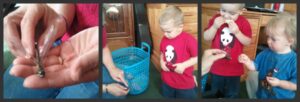
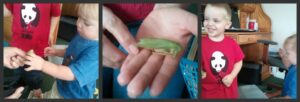
I eventually asked Mary if she wanted to hold the dragonfly. She reached out, pulled back, reached out, pulled back, and reached out again. Finally, she let me put it into her hand. She was fascinated. She chatted up a storm, pointing to the head, eyes, body, and wings. She handled it so much that, of course, the abdomen eventually broke loose. Then the head came off. She almost ate the head, thinking it looked like a piece of candy, I guess. I tell you, you gotta watch little ones! : )
Of course, Jack couldn’t be outdone by his “not quite 2-year-old” sister, so he came forward and held the katydid, but he wouldn’t have anything to do with the dragonfly. Mary also held the katydid completely fascinated.
Maggie, who was 5 ½, would have absolutely nothing to do with any bug in her hand!!!! She was firm about it and never budged. She was, however, mesmerized by the books and pored over every picture long after the others wandered off.
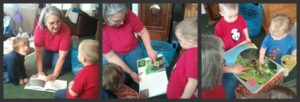
Interesting Dragonfly Facts for Kids
- Scientists attached tiny transmitters to dragonflies to see where they fly
- They have 3 main body parts: head, thorax, and abdomen
- Their compound eyes have 28,000 separate lenses per eye
- They are meat eaters with strong jaws
- They have a 3-part life cycle: egg, nymph, adult
- Males live 24 hours to several weeks, females slightly longer, so they can lay eggs
- Males are territorial
- Very few eggs hatch because so many things can go wrong
- The Japanese consider the dragonfly a sign of good luck
- In America, we sometimes call them mosquito hawks or darning needles
Make a Dragonfly
We made a simple paper dragonfly craft out of graduated circles of construction paper, wiggle eyes, and pipe cleaners. They enjoyed that project and flew them before we hung them up.
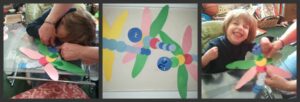
Books About Insects for Kids
- Dragonflies by Sophie Lockwood
- Dazzling Dragonflies by Linda Glaser
- Bugs Up Close by Diane Swanson
- Insects and Their Relatives by Maurice Burton
- Insects by Liz Wyse – This is a fabulous book for older kids, showing them how to experience being bugs themselves by creating bug parts to wear!
It was a fun day. Jack wanted to keep the katydid and show his dad how brave he was. The dragonfly, by this time, was in many pieces, due to Mary’s fascination.
The Outcome of this Learning Play
What has come from all this bug handling and picture book learning? I am known as the ‘bug grandma.” All my grands, those that live close and those who are far away, know that I love insects. I find them wherever I go, pick them up, talk about them, and have helped my grands overcome their fear of them. Most still don’t like them, but they aren’t afraid. They have mailed me specimens in small jewelry boxes. They have carefully carried them in the car when coming to visit.
On this last 4th of July weekend, we had a family reunion. One of my adult grands brought me two June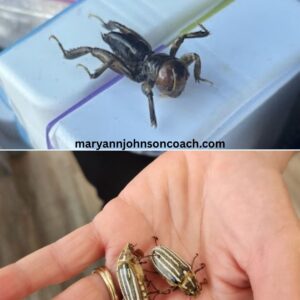 bugs that she found on the deck. She had picked them up without any trepidation. That same woman brought me a bug that I think was some type of cricket. It was fascinating.
bugs that she found on the deck. She had picked them up without any trepidation. That same woman brought me a bug that I think was some type of cricket. It was fascinating.
One of my great-grandchildren picked up and handled a toad. They were all over the place. I held a toad, too. : ) When we share what fascinates us, we can instill a love of the same in our children and grands. When we pay attention to what is sparking them, we can kindle a passion for learning and personal growth.
Learning play is a wonderful way to engage in conversations, teach principles, and introduce children to the world.






